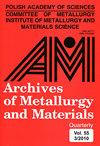Study of the Effect of Intensity of Vibrations and Temperature on the Cooling Characteristics of Quenching Media
IF 0.7
4区 材料科学
Q4 METALLURGY & METALLURGICAL ENGINEERING
引用次数: 0
Abstract
medIa Quenching technology requires the use of media with different cooling intensities and various shapes of cooling curves that show different particularities compared to that of conventional media such as water, oil, or emulsions. The use of synthetic quenching media is relatively new and also has multiple advantages such as non-flammability, safety in use and low cost. in this study, the cooling media tested was obtained by mixing 2 wt% carboxymethyl cellulose with 2 wt% Naoh in one litter of water. Moreover, three different temperatures (20°C, 40°C and 60°C) of the quenching media were evaluated. By dissolution in water, a synthetic solution with low viscosity, surfactant and lubricant was obtained. Because carboxymethyl cellulose is a biodegradable organic material, that is obtained as a by-product in the manufacture of paper, a basic substance with a preservative effect was added. according to this study, both the variation diagram of the heat transfer coefficient and the diagram of the cooling rates, during the cooling stages give important indications regarding the use of a liquid cooling medium for quenching.振动强度和温度对淬火介质冷却特性影响的研究
本文章由计算机程序翻译,如有差异,请以英文原文为准。
求助全文
约1分钟内获得全文
求助全文
来源期刊

Archives of Metallurgy and Materials
工程技术-冶金工程
CiteScore
1.20
自引率
0.00%
发文量
0
审稿时长
4.5 months
期刊介绍:
The Archives of Metallurgy and Materials is covered in the following Institute for Scientific Information products: SciSearch (the Science Citation Index - Expanded), Research Alert, Materials Science Citation Index, and Current Contents / Engineering, Computing and Technology.
Articles published in the Archives of Metallurgy and Materials are also indexed or abstracted by Cambridge Scientific Abstracts.
 求助内容:
求助内容: 应助结果提醒方式:
应助结果提醒方式:


